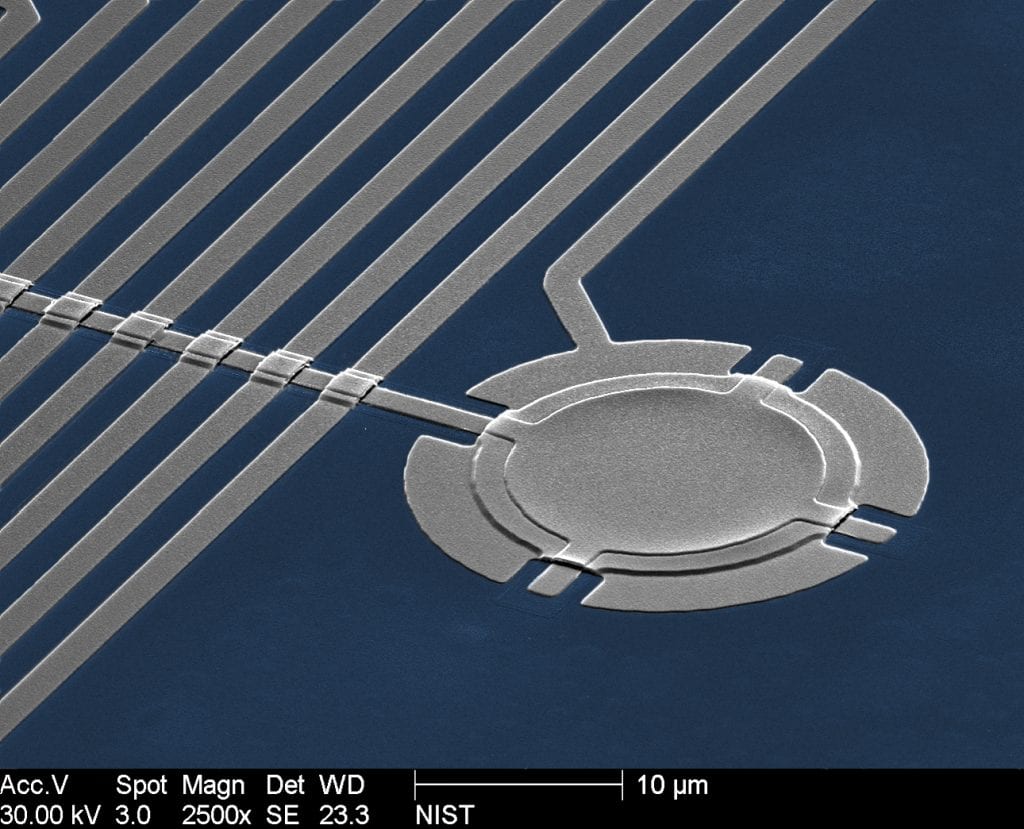
Researchers cooled an aluminum quantum drum to record low temperatures. These drums are integrated as memory devices, amplifiers, and sensors in a variety of research equipment. (Image Source: Wikimedia Commons)
According to a paper recently published in Nature, researchers at the National Institute of Standards and Technology (NIST) have cooled a vibrating drum to an unprecedented one-fifth of a quantum of energy, approaching the previously perceived limit of absolute zero (1).
Scientists use temperature to measure the thermal motion of atoms in an object. Although the laws of physics suggest the temperature of an object cannot reach absolute zero—the state at which absolutely no atomic movement occurs—the new NIST experiments demonstrate that a mechanical object can actually be cooled to one fifth of a quantum, lower than the generally established “quantum limit” (2).
The researchers embedded a twenty-micrometer-diameter aluminum membrane known as a quantum drum within a superconducting circuit, forming an electromagnetic cavity in which the drum’s motion generated microwaves. Within this cavity, the microwaves generated by the drum naturally aligned their frequency with that of the drum.
In previous experiments, scientists cooled similar drums to one-third of a quantum, the lowest established energy position at the time, otherwise known as ground state. Using a method called sideband cooling, researchers applied microwaves at a specific angle and frequency below the cavity’s resonance, creating an electrical charge and causing the drum to vibrate. The drum’s fluctuations, in turn, generated photons, which escaped from the cavity at a higher frequency than that of the incoming microwaves, thereby resulting in a net loss of mechanical energy from atoms within the drum.
The quantum nature of the photons, however, limited the amount of heat researchers could remove. As the photons departed from the cavity, the energy of the drum dropped; however, noise due to quantum intensity fluctuations collided with the drum, incrementally raising the drum’s temperature even while decreasing its overall energy. To combat this problem, the researchers carefully calibrated the photons to move at a specific intensity, “squeezing” the light. By forcing the particles to move in a straight path, they limited unwanted fluctuations. In doing so, they defied temperature limits previously established by conventional cooling techniques.
This advancement in quantum scale cooling holds promise for future research and employment in next-generation technology. Colder drums operate more precisely, allowing researchers to develop instruments with quantum level precision. Quantum computers, in particular, rely on a drum apparatus, and cooler drums—with their ability to mechanically hold information for longer periods of time—have the potential to enhance short-term memory devices. Other applications such as sensors, for instance, could improve in sensitivity and storage capacity, facilitating computations with less distortion. Furthermore, with colder quantum drums, researchers can ensure that fluctuations in data arise from significant physical forces rather than random atomic oscillation. Although larger objects, especially those that operate at low frequencies, are more difficult to cool than smaller objects like the quantum drum, these experiments have revealed great potential for technological advancement in quantum level cooling and its applications in technology.
References:
- Jeremy B. Clark, Florent Lecocq, Raymond W. Simmonds, José Aumentado, John D. Teufel. Sideband cooling beyond the quantum backaction limit with squeezed light. Nature, 2017; 541 (7636): 191 DOI: 10.1038/nature20604
- National Institute of Standards and Technology (NIST). (2017, January 11). Physicists ‘squeeze’ light to cool microscopic drum below quantum limit. ScienceDaily. Retrieved January 13, 2017 from www.sciencedaily.com/releases/2017/01/170111132808.htm
- Sanders, A. (2011, March 9). Aluminum Drum. Retrieved January 13, 2017, from https://commons.wikimedia.org/wiki/File:Aluminum_Drum_(5940426725).jpg